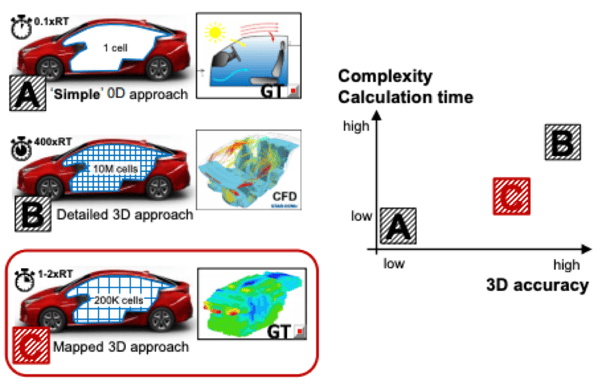With the cooler weather, many electric vehicle (EV) owners are preparing their best strategies to maintain a desirable range and keep warm. Sometimes EV owners must bundle up to mitigate HVAC usage to make it to their destination. These strategies are less than desirable, and so OEMs are working hard to minimize this issue with better cabin simulations for better designs.
Energy consumption in the cabin has a direct relation to the range of the vehicle. Traditional combustion engines can use waste heat to aid in occupant comfort. However, hybrid and electric cars do not have that luxury. The HVAC system and other comfort strategies (heated seats, radiant panels, etc.) drain the battery. Winter temperatures bring about the most significant increase in energy consumption. Winter consumption rates can make it so that EV drivers may have to choose between staying warm and getting to their destination and back.

Engineers must meet this particularly challenging request— designing an electric vehicle that is both energy efficient and comfortable for the occupant. Simulation has come a long way to assist engineers in their design trials. Gamma Technologies and ThermoAnalytics have created a co-simulation that enables engineers to validate their model and optimize occupant comfort based on energy consumption.
A vehicle system model (including power train, A/C system, and other subsystems) coupled with a 3D cabin model is required to answer this question. Some engineers rely on only modeling the A/C system or the cabin model alone. With those analyses, you lose the relationship between the occupant comfort and the vehicle's range.
Your model will have remarkable accuracy with a detailed CFD approach, but the calculation time will be arduous. A simple 0D method will give you a fast run time, but you will not have the accuracy you need. The co-simulation method offers a 'Goldilocks' approach that offers adequate accuracy and respectable run times.

Buyens, Nick, et al. “GT-SUITE and TAITherm Coupling Methodology for Transient Cabin Simulation Using 3D CFD Data.” European GT-SUITE Conference 2019. 2019.
The 'Goldilocks' approach is a standard GT-SUITE and TAITherm co-simulation process that uses 3D CFD data. An engineer would use a workflow such as:
- Begin with geometry
- Bring the CAD data into CFD and create the CFD model as well as a simplified mesh for the thermal structure
- Then, assign material properties to the TAITherm model
- Generate a CFD map and export as an ENSIGHT case file
- Read the ENSIGHT file into GT-SUITE
The data in the ENSIGHT file allows the engineer to create a map where they can take 3-10 different flow cases into GT-SUITE and interpolate between them to get something similar to the CFD solution much faster. ENSIGHT data is used to reconstruct the flow field. Each one of these files is created for each case run in CFD.

The co-simulation passes the near wall fluid temperatures and heat transfer coefficients to TAITherm, TAITherm passes a wall temperature back, then the simulation is run in 2x real-time. This co-simulation process automatically happens when GT-SUITE is given the ENSIGHT file, and then the engineer points to the TAITherm model.
This process enables engineers to run a design faster than traditional CFD methods with minimal impacts on accuracy. However, this process does require additional tools and multiple models that engineers would need to learn.
Other tools, such as the Human Thermal Extension developed by ThermoAnalytics, would allow engineers to use occupant comfort as a design target instead of air temperature. These new simulation methods help engineers solve competing priorities and help OEMs stay ahead of the curve.
If you want to learn more about using TAITherm to maximize your occupant comfort and electric vehicle range, please feel free to request a live demo of our software.
Visit our website at suppport.thermoanalytics.com for
- FAQs
- Webinars
- Tutorials
Get help from our technical support team:

